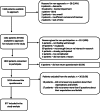Concordance of patient beliefs and expectations regarding the management of low back pain with guideline recommendations - a cross-sectional study in Germany
- PMID: 33342429
- PMCID: PMC7751122
- DOI: 10.1186/s12875-020-01352-1
Concordance of patient beliefs and expectations regarding the management of low back pain with guideline recommendations - a cross-sectional study in Germany
Abstract
Background: Low back pain is a common reason for patients to seek medical care. Physician non-adherence to clinical guidelines has been observed. We investigated the extent to which patient expectations correspond to recommendations of the German national guideline for management of low back pain (G-LBP) and whether patient characteristics, history of LBP and previous treatment experience are associated with expectations.
Methods: A cross-sectional study including patients from 13 general practices was conducted. Data were collected using a questionnaire. Inverse probability weights were used to address non-response bias. Descriptive analysis and multivariate logistic regression models were performed.
Results: A total of 977 patients were included in analyses (median age 57 years, 39% male). 75% of patients reported experiencing LBP currently or within the last year. More than 65% indicated they would agree to forgo further examinations if their LBP was judged by their physician to be of no serious concern. This was associated with the highest level of education and no prior imaging, and negatively associated with good-to-poor health status and moderate-to-severe pain intensity. 40% of participants expected imaging. The highest educational level, female gender and no prior imaging were associated with a decreased expectation of imaging. 70% expected prescriptions for massages. Females, participants with good-to-poor health status, current LBP or LBP in the last 12 months had an increased expectation for massages. Expectations for injection therapy (45%) were mainly associated with previous injections. Expectations for physiotherapy (64%) were associated with female gender, lower educational level, good-to-poor health status, current LBP or in the last 12 months. The perspective that daily activities should be continued (66%) was associated with female gender and higher educational level. Participants who agreed to the statement 'There is no effective treatment for LBP' (11%) had a poor health status, current LBP and a severe pain intensity.
Conclusion: Patient views regarding LBP management are partially concordant with guideline recommendations and are strongly influenced by previous treatment experiences and education level. Exploration of patient expectations and experiences in LBP treatment may help minimize dissatisfaction of patients expecting treatments not endorsed by guidelines and simultaneously increase physician guideline adherence.
Keywords: Clinical guidelines; Low back pain; Non-adherence; Patient expectations; Patient preferences.
Conflict of interest statement
Jean-François Chenot is one of the lead authors of the German national disease management guideline for low back pain. He is also an editorial board member of BMC Family Practice.
Figures
Similar articles
-
Concordance of Patient Expectations Regarding Guideline Recommendations for Management of Psychosocial Factors in Low Back Pain: A Cross-sectional Study.Pain Physician. 2022 Jul;25(4):E597-E607. Pain Physician. 2022. PMID: 35793184
-
Physical therapy for patients with low back pain in Germany: a survey of current practice.BMC Musculoskelet Disord. 2021 Jun 19;22(1):563. doi: 10.1186/s12891-021-04422-2. BMC Musculoskelet Disord. 2021. PMID: 34147077 Free PMC article.
-
Knowledge of and adherence to radiographic guidelines for low back pain: a survey of chiropractors in Newfoundland and Labrador, Canada.Chiropr Man Therap. 2021 Jan 18;29(1):4. doi: 10.1186/s12998-020-00361-2. Chiropr Man Therap. 2021. PMID: 33461555 Free PMC article.
-
Sociodemographic determinants of health inequities in low back pain: a narrative review.Front Public Health. 2024 Sep 11;12:1392074. doi: 10.3389/fpubh.2024.1392074. eCollection 2024. Front Public Health. 2024. PMID: 39324158 Free PMC article. Review.
-
Individual recovery expectations and prognosis of outcomes in non-specific low back pain: prognostic factor review.Cochrane Database Syst Rev. 2019 Nov 25;2019(11):CD011284. doi: 10.1002/14651858.CD011284.pub2. Cochrane Database Syst Rev. 2019. PMID: 31765487 Free PMC article.
Cited by
-
Healthcare provider perspectives on integrating a comprehensive spine care model in an academic health system: a cross-sectional survey.BMC Health Serv Res. 2024 Jan 23;24(1):125. doi: 10.1186/s12913-024-10578-z. BMC Health Serv Res. 2024. PMID: 38263013 Free PMC article.
-
Guideline adherence of physiotherapists in the treatment of patients with low back pain: A qualitative study.J Eval Clin Pract. 2022 Dec;28(6):1147-1156. doi: 10.1111/jep.13703. Epub 2022 May 26. J Eval Clin Pract. 2022. PMID: 35615965 Free PMC article.
-
An exploration of patients' perceptions and coping strategies for LBP.PLoS One. 2025 Jun 9;20(6):e0324859. doi: 10.1371/journal.pone.0324859. eCollection 2025. PLoS One. 2025. PMID: 40489483 Free PMC article.
-
Patient expectations and levels of satisfaction in chiropractic treatment for lumbar radiculopathy. A mixed methods study.Chiropr Man Therap. 2023 May 19;31(1):13. doi: 10.1186/s12998-023-00486-0. Chiropr Man Therap. 2023. PMID: 37208689 Free PMC article.
-
The effect of clinical guidelines on the utilisation of radiographs in chiropractic clinics in Denmark - an interrupted time series analysis.Chiropr Man Therap. 2023 Nov 22;31(1):47. doi: 10.1186/s12998-023-00518-9. Chiropr Man Therap. 2023. PMID: 37993957 Free PMC article.
References
-
- James SL, Abate D, Abate KH, Abay SM, Abbafati C, Abbasi N, et al. Global, regional, and national incidence, prevalence, and years lived with disability for 354 diseases and injuries for 195 countries and territories, 1990–2017: a systematic analysis for the global burden of disease study 2017. Lancet. 2018;392(10159):1789–1858. doi: 10.1016/S0140-6736(18)32279-7. - DOI - PMC - PubMed
-
- Neuhauser H, Ellert U, Ziese T. Chronische Rückenschmerzen in der Allgemeinbevölkerung in Deutschland 2002/2003: Prävalenz und besonders betroffene Bevölkerungsgruppen [Chronic Back Pain in the General Population in Germany 2002/2003:Prevalence and Highly Affected Population Groups] Gesundheitswesen. 2005;67(10):685–693. doi: 10.1055/s-2005-858701. - DOI - PubMed
-
- Chenot JF, Haupt C, Gerste B. Zeitliche Trends bei der Versorgung von Rückenschmerzpatienten [Trends in care of back pain patients] In: Klauber J, Günster C, Gerste B, Robra B-P, Schmacke N, editors. Versorgungs-report 2013: Schwerpunkt: depression. Stuttgart: Schattauer; 2013. pp. 155–184.
-
- Nationale VersorgungsLeitlinie Nicht-spezifischer Kreuzschmerz [Clinical practice guideline: Non-specific low back pain]: Langfassung; 2017 [cited 2019 Jul 1]. Available from: URL: https://www.leitlinien.de/mdb/downloads/nvl/kreuzschmerz/kreuzschmerz-2a....
Publication types
MeSH terms
LinkOut - more resources
Full Text Sources
Miscellaneous


